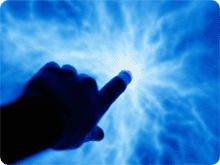 |
|
Backbone - A cable connection between telecommunication
or wiring closets, floor distribution terminals, entrance
facilities, and equipment rooms either within or between buildings.
In star networks, the backbone cable interconnects hubsand
similar devices, as opposed to cables running between hub
and station. In a bus network, the bus cable.
Back reflection - The light reflected back towards
the source from the fiber optic ends and deformations.
Backscattering - Refers to light diffraction at microscopic
non-uniformities in the index of refraction of the optical
fiber causing back reflection of optical power towards the
source. Used in OTDRs.
Balanced Cable, Balanced Line - A cable having two identical
conductors that carry voltages of opposite polarities and
equal magnitude with respect to ground. The conductors are
twisted to maintain balance over a distance.
Balanced Transmission - A mode of signal transmission
in which each conductor carries the signal of equal magnitude,
but opposite polarity. A 5 volt signal for example, appears
as a +2.5 Volts on one conductor and -2.5 Volts on the other.
Balun - An impedance matching transformer that converts
the impedance of one interface to the impedance of another
interface. Generally used to connect balanced twisted pair
cabling with unbalanced coaxial cabling. The term is derived
from "balanced / unbalanced".
Bandpass - A range of frequencies or wavelengths within
which a component operates.
Baseband - A transmission method in which the entire
bandwidth of the transmission medium is used to transmit a
single digital signal. The signal is driven directly onto
the transmission medium without modulation of any kind. Baseband
is simpler, cheaper and less sophisticated than Broadband.
Bandwidth - The range of frequencies required for proper
transmission of a signal. Expressed in Hertz (cycles per second).
The higher the bandwidth, the more information that can be
carried. A continuous range starting from zero is said to
be "baseband", while a range starting substantially
above zero is "broadband".
Baud - The number of changes in signal per second.
A given baud rate does not necessarily transmit an equal number
of bits/sec. For example, a signal with four voltage levels
may be used to transfer two bits of information for every
baud.
Beacon -A special frame in Token-Ring systems indicating
a serious problem with the ring such as a break.
Bel - A unit that represents the logarithm of the ratio
of two levels.
Bend Loss - A form of increased attenuation in an optical
fiber caused by an excessively small bend radius. The attenuation
may be permanent if micro-fractures caused by the bend continue
to affect transmission of the light signal.
Bend Radius - Radius of curvature that a fiber optic
or metallic cable can bend before the risk of breakage or
increased attenuation occurs.
BER - see Bit Error Rate
BICSI - Building Industry Consulting Service International.
Binder - A tape or thread used to hold assembled cable
components in place.
BISDN - Broadband ISDN
Bit - One binary digit.
Bit Error Rate - A measure of data integrity, expressed
as the ratio of received bits that are in error, relative
to the amount of bits received. Often expressed as a negative
power of ten.
Bit Stream - A continuous transfer of bits over some
medium.
Bit Stuffing - A method of breaking up continuous strings
of 1 bits by inserting a 0 bit. The 0 bit is removed at the
receiver.
Bit Time - The length of time required to transmit
one bit of information.
BL - Blue.
BNC - A coaxial connector that uses a "bayonet"
style turn and lock mating method. Used with RG-58 or smaller
coaxial cable. Used with 10Base2 Ethernet thin coaxial cable.
BNC is an acronym for Bayonet-Neill-Concelman.
Bonding - A method used to produce good electrical
contact between metallic parts. Also refers to the grounding
bars and straps used in buildings to bond equipment to an
approved ground.
BPS - Bits per second.
BR - Brown.
Braid - Fine wires interwoven to form a tubular flexible
structure that may be applied over one or more wires for the
purpose of shielding. May also be formed into a flattened
conductor to be used as a grounding strap.
BRI - ISDN Basic Rate Interface
Bridged Tap - Multiple appearances of the same cable
pair at several distribution points.
Broadband - A transmission facility having a bandwidth
sufficient to carry multiple voice, video or data channels
simultaneously. Each channel occupies (is modulated to) a
different frequency bandwidth on the transmission medium and
is demodulated to its original frequency at the receiving
end. Channels are separated by "guardbands" (empty
spaces) to ensure that each channel will not interfere with
its neighboring channels. This technique is used to provide
many CATV channels on one coaxial cable.
Broadcast - Sending data to more than one receiving
device at a time.
Buffer - A protective coating over a strand of optical
fiber.
Bus Topology - 1. In general, a physical layout of
network devices in which all devices must share a common medium
to transfer data, and no two devices may transmit simultaneously.
With LANs, a linear network topology in which all computers
are connected to a single cable.
Butyl Rubber -A synthetic rubber with good electrical
insulating properties.
Byte - A group of 8 bits.
|

